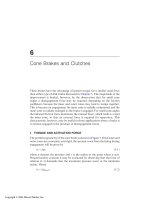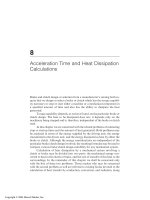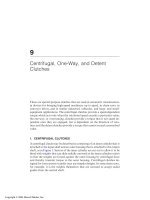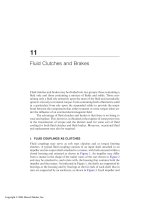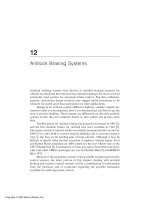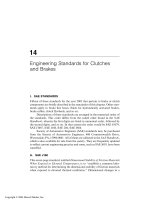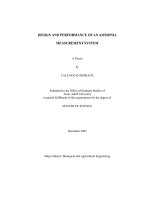Design and Implementation of VLSI Systems_Lecture 06: Circuit characterization and performance estimation ppt
Bạn đang xem bản rút gọn của tài liệu. Xem và tải ngay bản đầy đủ của tài liệu tại đây (1.43 MB, 77 trang )
Design and Implementation
of VLSI Systems
Lecture 06
Thuan Nguyen
Faculty of Electronics and Telecommunications,
University of Science, VNU HCMUS
Spring 2011
1
INTRODUCTION
The delay of a logic gate:
C: load capacitance
t ∝
𝐶
𝐼
∆𝑉 I: output current
∆𝑉: output voltage swing
2
nMOS provides more current than pMOS for the same size
and capacitance
Static CMOS requires both nMOS and pMOS on each
input.
All the node voltages in static CMOS must transition
between 0 and V
DD
propagation delay + power
consumption.
Circuit families
LECTURE 06: CIRCUIT CHARACTERIZATION &
PERFORMANCE ESTIMATION
Static CMOS
1
Ratioed Circuits
2
Dynamic Circuits
3
Pass-transistor Circuits
4
3
LECTURE 06: CIRCUIT CHARACTERIZATION &
PERFORMANCE ESTIMATION
Static CMOS
1
Ratioed Circuits
2
Dynamic Circuits
3
Pass-transistor Circuits
4
4
OUTLINE
Bubble Pushing
Compound Gates
Logical Effort Example
Input Ordering
Asymmetric Gates
Skewed Gates
Best P/N ratio
5
EXAMPLE 1
module mux(input s, d0, d1,
output y);
assign y = s ? d1 : d0;
endmodule
1) Sketch a design using AND, OR, and NOT gates.
D0
S
D1
S
Y
6
EXAMPLE 2
Y
D0
S
D1
S
7
module mux(input s, d0, d1,
output y);
assign y = s ? d1 : d0;
endmodule
2) Sketch a design using NAND, NOR, and NOT
gates. Assume ~S is available.
BUBBLE PUSHING
Start with network of AND / OR gates
Convert to NAND / NOR + inverters
Push bubbles around to simplify logic
Remember DeMorgan’s Law
Y Y
Y
D
Y
(a) (b)
(c) (d)
8
EXAMPLE 3
module mux(input s, d0, d1,
output y);
assign y = s ? d1 : d0;
Endmodule
3) Sketch a design using one compound gate and one
NOT gate. Assume ~S is available.
Y
D0
S
D1
S
9
COMPOUND GATES
Logical Effort of compound gates
A
B
C
D
Y
A
B
C
Y
A
B
C
C
A B
A
B
C
D
A
C
B
D
2
2
1
4
44
2
2 2
2
4
4 4
4
g
A
= 6/3
g
B
= 6/3
g
C
= 5/3
p = 7/3
g
A
= 6/3
g
B
= 6/3
g
C
= 6/3
p = 12/3
g
D
= 6/3
YA
A Y
g
A
= 3/3
p = 3/3
2
1
YY
unit inverter AOI21 AOI22
A
C
D
E
Y
B
Y
B C
A
D
E
A
B
C
D E
g
A
= 5/3
g
B
= 8/3
g
C
= 8/3
g
D
= 8/3
2
2 2
22
6
6
6 6
3
p = 16/3
g
E
= 8/3
Complex AOI
Y A B C
Y A B C D
Y A B C D E
YA
10
EXAMPLE 4
The multiplexer has a maximum input capacitance
of 16 units on each input. It must drive a load of
160 units. Estimate the delay of the two designs.
2 2 4
(4/3) (4/3) 16/9
160/9
ˆ
4.2
ˆ
12.4
N
P
G
F GBH
fF
D Nf P
Y
D0
S
D1
S
Y
D0
S
D1
S
H = 160 / 16 = 10 B = 1 N = 2
4 1 5
(6/3) (1) 2
20
ˆ
4.5
ˆ
14
N
P
G
F GBH
fF
D Nf P
11
6
6 6
6
10
10
Y
24
12
10
10
8
8
88
8
8
88
25
25
2525
Y
16
16160 * (4/3) / 4.2 = 50 160 * 1 / 4.5 = 36
EXAMPLE 5
Annotate your designs with transistor sizes that
achieve this delay.
Y
8
8
88
8
8
88
25
25
2525
Y
16
160 * (4/3) / 4.2 = 50
YY
12
INPUT ORDER
Our parasitic delay model was too simple
Calculate parasitic delay for Y falling
If A arrives latest? 2
If B arrives latest? 2.33
6C
2C
2
2
2
2
B
A
x
Y
13
INNER & OUTER INPUTS
Inner input is closest to output (A)
Outer input is closest to rail (B)
If input arrival time is known
Connect latest input to inner terminal
2
2
2
2
A
B
Y
14
ASYMMETRIC GATES
Asymmetric gates favor one input over another
Ex: suppose input A of a NAND gate is most critical
Use smaller transistor on A (less capacitance)
Boost size of noncritical input
So total resistance is same
g
A
= 10/9
g
B
= 2
g
total
= g
A
+ g
B
= 28/9
Asymmetric gate approaches g = 1 on critical input
But total logical effort goes up
A
reset
Y
4
4/3
2
2
reset
A
Y
15
SYMMETRIC GATES
Inputs can be made perfectly symmetric
A
B
Y
2
1
1
2
1
1
16
SKEWED INVERTER
Transfer characteristics of
skewed inverter
17
o
𝛽
𝑛
𝛽
𝑝
= 1: un-skewed inv
o
𝛽
𝑛
𝛽
𝑝
> 1: HI-skewed inv
o
𝛽
𝑛
𝛽
𝑝
< 1: LO-skewed inv
SKEWED GATES
Skewed gates favor one edge over another
Ex: suppose rising output of inverter is most
critical
Downsize noncritical nMOS transistor
Calculate logical effort by comparing to
unskewed inverter with same effective resistance
on that edge.
g
u
= 2.5 / 3 = 5/6
g
d
= 2.5 / 1.5 = 5/3
1/2
2
A Y
1
2
A Y
1/2
1
A Y
HI-skew
inverter
unskewed inverter
(equal rise resistance)
unskewed inverter
(equal fall resistance)
18
HI- AND LO-SKEW
Def: Logical effort of a skewed gate for a
particular transition is the ratio of the input
capacitance of that gate to the input capacitance
of an un-skewed inverter delivering the same
output current for the same transition.
Skewed gates reduce size of noncritical
transistors
HI-skew gates favor rising output (small nMOS)
LO-skew gates favor falling output (small pMOS)
Logical effort is smaller for favored direction
But larger for the other direction
19
1/2
2
A Y
Inverter
1
1
2
2
B
A
Y
B
A
NAND2 NOR2
1/21/2
4
4
HI-skew
LO-skew
1
1
A Y
2
2
1
1
B
A
Y
B
A
11
2
2
g
u
= 5/6
g
d
= 5/3
g
avg
= 5/4
g
u
= 4/3
g
d
= 2/3
g
avg
= 1
g
u
= 1
g
d
= 2
g
avg
= 3/2
g
u
= 2
g
d
= 1
g
avg
= 3/2
g
u
= 3/2
g
d
= 3
g
avg
= 9/4
g
u
= 2
g
d
= 1
g
avg
= 3/2
Y
Y
1
2
A Y
2
2
2
2
B
A
Y
B
A
11
4
4
unskewed
g
u
= 1
g
d
= 1
g
avg
= 1
g
u
= 4/3
g
d
= 4/3
g
avg
= 4/3
g
u
= 5/3
g
d
= 5/3
g
avg
= 5/3
Y
CATALOG OF SKEWED GATES
20
21
ASYMMETRIC SKEW
Combine asymmetric and skewed gates
Downsize noncritical transistor on unimportant input
Reduces parasitic delay for critical input
A
reset
Y
4
4/3
2
1
reset
A
Y
22
BEST P/N RATIO
We have selected P/N ratio for unit rise and fall
resistance (m = 2-3 for an inverter).
Alternative: choose ratio for least average delay
Ex: inverter
Delay driving identical inverter
t
= (P+1)
t
pdr
= (P+1)(m/P)
t
pd
= (P+1)(1+m/P)/2 = (P + 1 + m + m/P)/2
dt
pd
/ dP = (1- m/P
2
)/2 = 0
Least delay for P =
m
23
Inverter NAND2 NOR2
1
1.414
A Y
2
2
2
2
B
A
Y
B
A
11
2
2
fastest
P/N ratio
g
u
= 1.15
g
d
= 0.81
g
avg
= 0.98
g
u
= 4/3
g
d
= 4/3
g
avg
= 4/3
g
u
= 2
g
d
= 1
g
avg
= 3/2
Y
Inverter NAND2 NOR2
1
1.414
A Y
2
2
2
2
B
A
Y
B
A
11
2
2
fastest
P/N ratio
g
u
=
g
d
=
g
avg
=
g
u
=
g
d
=
g
avg
=
g
u
=
g
d
=
g
avg
=
Y
P/N RATIOS
In general, best P/N ratio is sqrt of equal delay
ratio.
Only improves average delay slightly for inverters
But significantly decreases area and power
24
OBSERVATIONS
For speed:
NAND vs. NOR
Many simple stages vs. fewer high fan-in stages
Latest-arriving input
For area and power:
Many simple stages vs. fewer high fan-in stages
STATIC CMOS CIRCUIT (REVIEW)
At every point in time (except during the switching
transients) each gate output is connected to
either V
DD
or V
SS
via a low-resistive path.
The outputs of the gates assume at all times the
value of the Boolean function, implemented by
the circuit (ignoring, once again, the transient effects
during switching periods).
This is in contrast to the dynamic circuit class,
which relies on temporary storage of signal values on
the capacitance of high impedance circuit nodes.
25

